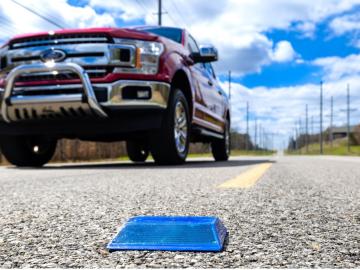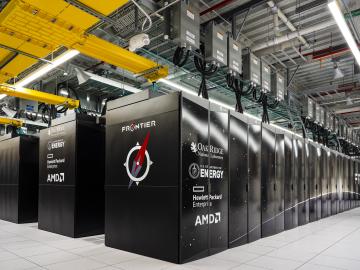
Filter News
Area of Research
- (-) Energy Science (171)
- (-) National Security (40)
- (-) Supercomputing (118)
- Advanced Manufacturing (22)
- Biology and Environment (36)
- Building Technologies (2)
- Computational Biology (1)
- Computational Engineering (3)
- Computer Science (16)
- Electricity and Smart Grid (1)
- Fuel Cycle Science and Technology (1)
- Functional Materials for Energy (1)
- Fusion and Fission (30)
- Fusion Energy (11)
- Isotope Development and Production (1)
- Isotopes (27)
- Materials (77)
- Materials for Computing (16)
- Mathematics (1)
- Neutron Science (30)
- Nuclear Science and Technology (39)
- Nuclear Systems Modeling, Simulation and Validation (1)
- Quantum information Science (6)
- Transportation Systems (2)
News Topics
- (-) 3-D Printing/Advanced Manufacturing (83)
- (-) Artificial Intelligence (50)
- (-) Computer Science (116)
- (-) Cybersecurity (28)
- (-) Isotopes (2)
- (-) Nuclear Energy (14)
- (-) Transportation (72)
- Advanced Reactors (8)
- Big Data (30)
- Bioenergy (31)
- Biology (22)
- Biomedical (22)
- Biotechnology (7)
- Buildings (39)
- Chemical Sciences (16)
- Clean Water (8)
- Composites (17)
- Coronavirus (27)
- Critical Materials (12)
- Energy Storage (74)
- Environment (73)
- Exascale Computing (27)
- Fossil Energy (2)
- Frontier (32)
- Fusion (3)
- Grid (45)
- High-Performance Computing (46)
- Hydropower (3)
- Machine Learning (28)
- Materials (46)
- Materials Science (41)
- Mathematics (4)
- Mercury (3)
- Microelectronics (1)
- Microscopy (14)
- Molten Salt (1)
- Nanotechnology (15)
- National Security (38)
- Neutron Science (22)
- Partnerships (16)
- Physics (9)
- Polymers (13)
- Quantum Computing (20)
- Quantum Science (27)
- Security (18)
- Simulation (18)
- Software (1)
- Space Exploration (6)
- Statistics (1)
- Summit (44)
Media Contacts

Tristen Mullins enjoys the hidden side of computers. As a signals processing engineer for ORNL, she tries to uncover information hidden in components used on the nation’s power grid — information that may be susceptible to cyberattacks.

Scientist-inventors from ORNL will present seven new technologies during the Technology Innovation Showcase on Friday, July 14, from 8 a.m.–4 p.m. at the Joint Institute for Computational Sciences on ORNL’s campus.

Working with Western Michigan University and other partners, ORNL engineers are placing low-powered sensors in the reflective raised pavement markers that are already used to help drivers identify lanes. Microchips inside the markers transmit information to passing cars about the road shape to help autonomous driving features function even when vehicle cameras or remote laser sensing, called LiDAR, are unreliable because of fog, snow, glare or other obstructions.

To support the development of a revolutionary new open fan engine architecture for the future of flight, GE Aerospace has run simulations using the world’s fastest supercomputer capable of crunching data in excess of exascale speed, or more than a quintillion calculations per second.

Innovations in artificial intelligence are rapidly shaping our world, from virtual assistants and chatbots to self-driving cars and automated manufacturing.

Like most scientists, Chengping Chai is not content with the surface of things: He wants to probe beyond to learn what’s really going on. But in his case, he is literally building a map of the world beneath, using seismic and acoustic data that reveal when and where the earth moves.

For more than 100 years, Magotteaux has provided grinding materials and castings for the mining, cement and aggregates industries. The company, based in Belgium, began its international expansion in 1968. Its second international plant has been a critical part of the Pulaski, Tennessee, economy since 1972.

ORNL scientists found that a small tweak created big performance improvements in a type of solid-state battery, a technology considered vital to broader electric vehicle adoption.

An innovative and sustainable chemistry developed at ORNL for capturing carbon dioxide has been licensed to Holocene, a Knoxville-based startup focused on designing and building plants that remove carbon dioxide

A study led by researchers at ORNL could uncover new ways to produce more powerful, longer-lasting batteries and memory devices.


